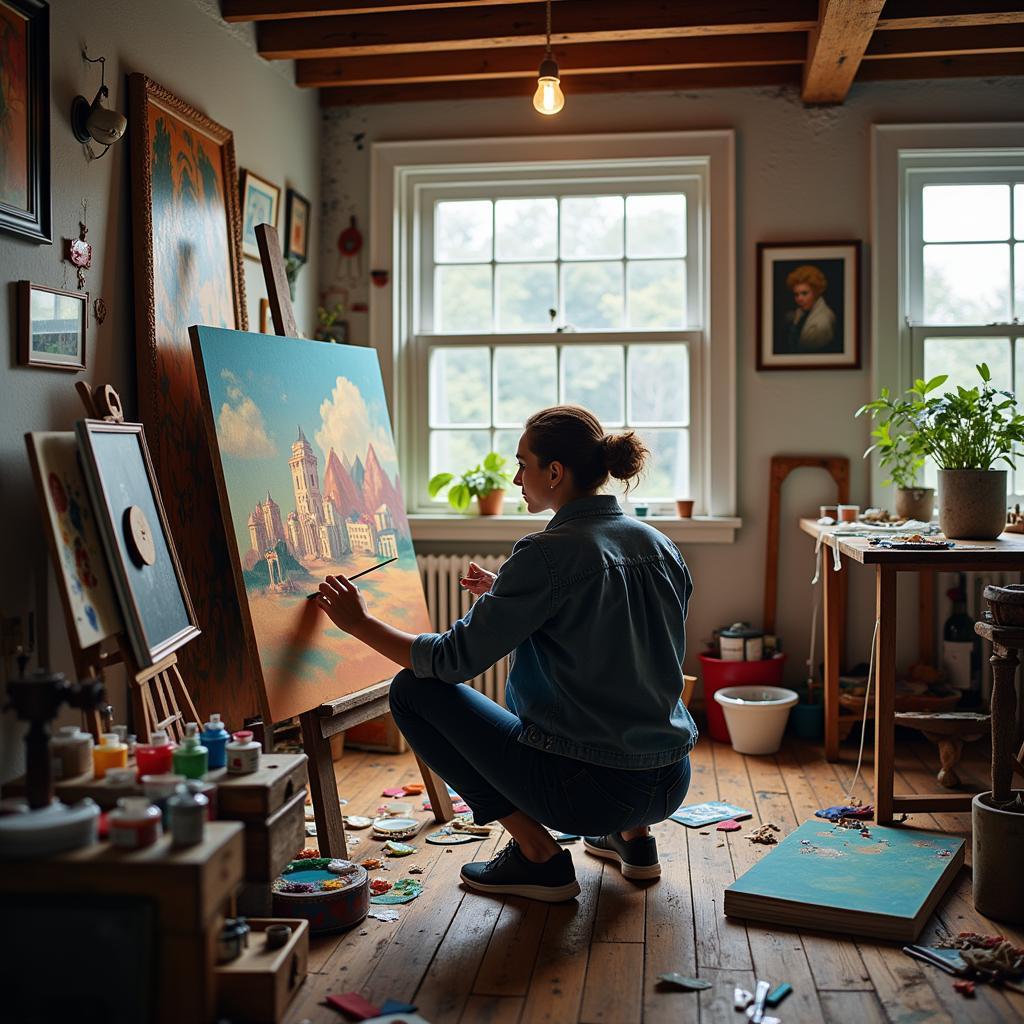Mastering Oil Based Art Paint: A Deep Dive into Techniques and Materials
Oil Based Art Paint has captivated artists for centuries, offering a richness and depth unmatched by other mediums. From the Old Masters to contemporary creators, the allure of oil paints lies in their versatility, luminosity, and ability to capture the subtlest nuances of light and shadow. This guide explores the world of oil based art paint, delving into its unique properties, essential materials, and diverse techniques.
Understanding the Allure of Oil Based Art Paint
Why choose oil based art paint? Its slow drying time allows for extensive blending and layering, giving artists unparalleled control over their work. This characteristic also enables the creation of smooth transitions and intricate details. The luminous quality of oil paint, derived from its interaction with light, creates a depth and vibrancy that truly brings artwork to life. Whether you’re a seasoned artist or a curious beginner, exploring the world of oil painting can be a rewarding journey. Check out some inspiring boat art to see the diverse applications of this medium.
Essential Materials for Oil Painting
Before embarking on your oil painting journey, gathering the right materials is crucial. Here’s a breakdown of the essentials:
- Paints: Invest in a set of high-quality oil paints, offering a range of pigments. Start with a basic palette and expand as you experiment.
- Brushes: Choose a variety of brush shapes and sizes to achieve different effects. Round, flat, filbert, and fan brushes are common choices.
- Palette: A palette is essential for mixing and organizing your colors. Glass, wood, and disposable paper palettes are all viable options.
- Mediums: Mediums are used to modify the consistency, drying time, and finish of oil paints. Linseed oil and turpentine are common examples.
- Canvas: Canvas is the most popular surface for oil painting, offering a textured surface that holds the paint well. Other options include wood panels and linen.
- Solvents: Solvents are used for cleaning brushes and thinning paints. Odorless mineral spirits are a safer alternative to traditional turpentine.
Exploring Oil Painting Techniques
The beauty of oil based art paint lies in the myriad techniques it allows. Here are a few to explore:
- Blending: The slow drying time of oil paint makes it ideal for creating smooth transitions between colors.
- Layering (Glazing): Applying thin, transparent layers of paint over dried layers creates depth and luminosity. Want to see more beautiful art created with these techniques? Explore the world’s most beautiful art.
- Impasto: Applying thick layers of paint creates texture and dimension.
- Scumbling: Dragging a dry brush loaded with a small amount of paint over a dried layer creates a textured effect.
- Dry Brushing: Applying a small amount of paint to a dry brush and lightly brushing it over the surface creates a broken, textured effect.
What are the advantages of using oil based art paint?
Oil paints offer a unique blend of vibrancy and control. Their slow drying time allows for meticulous blending and layering, making them perfect for capturing intricate details and achieving smooth transitions. This characteristic also allows artists to rework areas over an extended period, providing flexibility and room for experimentation. Discover the vibrant world of gel art paint for another fascinating medium.
 Artist working on an oil painting in a studio, surrounded by art supplies.
Artist working on an oil painting in a studio, surrounded by art supplies.
How do I clean my oil painting brushes?
Cleaning your brushes after each painting session is crucial for their longevity. Use mineral spirits or turpentine to remove the paint, followed by a thorough wash with soap and water.
Renowned artist, Anya Petrova, shares her perspective, “Oil painting allows me to capture the fleeting beauty of light and shadow. The slow drying time gives me the freedom to explore and refine my work until it truly reflects my vision.” She emphasizes the importance of quality materials, “Investing in good brushes and paints is an investment in your artistic journey.”
Another expert, David Chen, adds, “Oil painting is a constant learning process. Don’t be afraid to experiment with different techniques and mediums to discover your own unique style.” This could involve exploring niche areas like b 17g nose art to understand the unique applications of this versatile medium.
In conclusion, oil based art paint offers a captivating journey into the world of art. With its unique properties and diverse techniques, it allows for limitless creative expression. So, gather your materials, embrace the process, and discover the magic of oil painting. Looking for art to inspire your own creations? Check out pittsburgh art for sale.
FAQ
- What is the best surface for oil painting?
- How do I thin oil paint?
- What are the different types of oil painting mediums?
- How do I store oil paints?
- How long does it take for oil paint to dry completely?
- What is the difference between student grade and artist grade oil paints?
- How do I prevent my oil paintings from cracking?
Need support? Contact us 24/7 at Phone: 02462573573, Email: [email protected] or visit us at Savico Megamall, 7-9 Đ. Nguyễn Văn Linh, Gia Thụy, Long Biên, Hà Nội 10000, Việt Nam.


